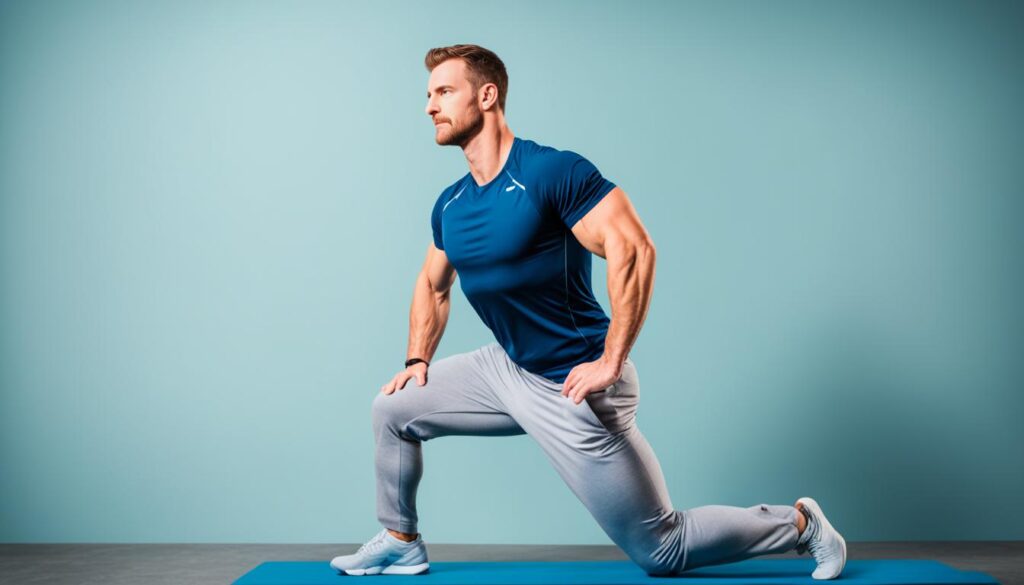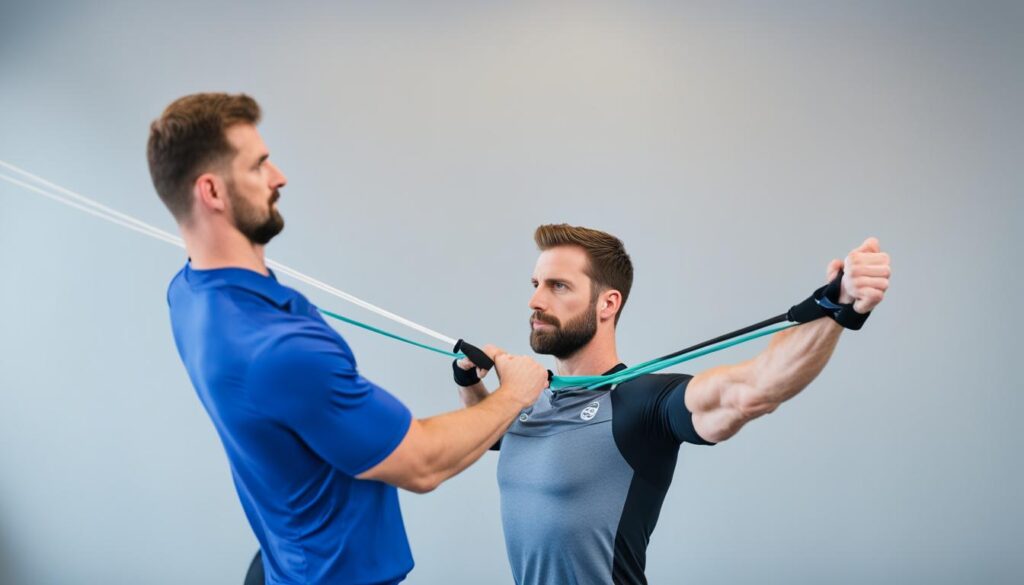Shoulder surgery recovery is a crucial step in the healing process. Regular exercises to restore motion and flexibility to the shoulder, along with a gradual return to everyday activities, are essential for full recovery1. Physical therapy and customized exercise programs are key to a successful shoulder surgery recovery. This article provides a comprehensive guide on safe and effective workout routines, exercises, and tips to regain strength and mobility during shoulder surgery recovery.
Key Takeaways
- Shoulder surgery recovery often involves increased pain compared to pre-surgery levels.
- Specific exercises, including range of motion, strengthening, and endurance exercises, are recommended for post-surgery recovery.
- Physical therapy may be recommended by orthopedic doctors to aid in post-surgery recovery.
- Customized physical therapy programs are typically used to facilitate recovery after shoulder surgery.
- Following the prescribed exercise routine and consulting with a healthcare provider is essential for a successful recovery.
Introduction to Shoulder Surgery Recovery
Recovering from shoulder surgery can be a challenging but essential process. After the procedure, physical therapy plays a crucial role in regaining range of motion, strength, and flexibility in the shoulder2. Surgeons and physical therapists recommend exercising for 10 to 15 minutes, 2 or 3 times a day during the early recovery period2.
Importance of Physical Therapy
Physical therapy is vital for a successful shoulder surgery recovery. A physical therapist will design a customized exercise program to help patients achieve their specific recovery goals2. These personalized programs can significantly shorten the shoulder surgery recovery timeline2. Consistent exercise under the guidance of a physical therapist can make a substantial difference in the healing process.
Customized Exercise Programs
Every patient’s shoulder surgery recovery is unique, and their physical therapy program should reflect that. Physical therapists create customized exercise routines based on the individual’s surgery, injury, and recovery goals3. These programs often include a variety of exercises to improve mobility, strength, and flexibility in the shoulder2. By tailoring the exercises to the patient’s needs, physical therapists can help ensure a more efficient and effective recovery.
Shoulder surgery recovery can be a complex and lengthy process, but with the right physical therapy plan, patients can regain their strength and range of motion3. By working closely with a physical therapist and following their customized exercise program, individuals can maximize their chances of a successful and timely recovery243.
Circular Pendulum Exercise
The circular pendulum exercise is a crucial rehabilitation technique recommended to improve shoulder mobility after surgery5. This exercise, developed by the renowned orthopedic surgeon Edina Codman, targets a wide range of shoulder conditions, including rotator cuff tears, adhesive capsulitis (frozen shoulder), labral tears, collarbone fractures, and shoulder dislocations5.
The shoulder joint is known for its remarkable 360-degree range of motion, but this complexity also makes it vulnerable to injury5. To perform the circular pendulum exercise, the patient should bend forward 90 degrees at the waist, placing the uninvolved hand on a table for support. The patient then gently rocks their body in a circular pattern, moving the arm clockwise 10 times and then counterclockwise 10 times, keeping the arm relaxed throughout the exercise6. This circular motion helps restore flexibility and range of motion in the shoulder joint, aiding the recovery process5.
A 2006 study compared weighted and unweighted pendulum exercises, finding that adding 3.3 pounds (1.5 kg) to standing pendulum exercises did not increase muscle activation when performed correctly5. Patients are advised to focus on the pendulum motion itself, ensuring proper technique and avoiding excessive muscle tension during the exercise7.
Improving Shoulder Mobility
The circular pendulum exercise is a valuable tool for improving shoulder mobility after surgery7. By gently moving the arm in a circular pattern, patients can regain flexibility and range of motion in the shoulder joint, which is crucial for a successful recovery5. The exercise is often recommended as part of a comprehensive rehabilitation program, tailored to the patient’s specific needs and the type of shoulder surgery performed7.
Patients are encouraged to perform the circular pendulum exercise at least 5 times a day, with a minimum of 10 repetitions in each direction6. Consistent practice and adherence to the recommended frequency and duration can significantly improve shoulder mobility and facilitate a faster recovery6.
While the circular pendulum exercise is a fundamental part of shoulder rehabilitation, it is important to note that different shoulder surgeries may require specific post-operative rehabilitation plans7. Patients should consult with their healthcare providers to ensure they are following the appropriate exercise regimen for their individual condition and stage of recovery7.
Shoulder Elevation Exercise
After undergoing shoulder surgery, engaging in targeted exercises can play a crucial role in regaining range of motion and restoring shoulder function. One such exercise that can be highly beneficial is the shoulder elevation exercise8. This simple yet effective exercise can be performed either in a lying-down or sitting position, making it accessible for patients at various stages of their recovery journey.
To perform the shoulder elevation exercise, the patient should clasp their hands together and slowly lift their arms above their head, keeping the elbows as straight as possible8. This motion helps to increase the range of motion in the shoulder joint and can be an important part of the rehabilitation process. The arms are held in the elevated position for 10-20 seconds, then slowly lowered back down.
It’s important to note that during the recovery period, certain movements should be avoided to prevent further injury and disruption to the healing process. For instance, overhead motions of the arm should be avoided after rotator cuff repair surgery as they place excessive stress on the shoulder joint8. Additionally, exercises involving heavy weights should not be performed with either arm until cleared by a doctor or physical therapist8.
To ensure a safe and effective recovery, it’s crucial to follow the guidance of your healthcare team, which may include a physical therapist. They can provide personalized recommendations on the appropriate exercises and progressions based on your individual needs and the stage of your recovery9. By working closely with your healthcare providers and diligently performing exercises like the shoulder elevation exercise, you can work towards regaining your shoulder’s full range of motion and function.
Remember, every person’s recovery journey is unique, so it’s important to listen to your body and communicate any concerns or questions you may have with your healthcare team9. By staying proactive and committed to your rehabilitation, you can maximize your chances of a successful recovery and a return to the activities you enjoy8910.
“Walk” Up a Wall Exercise
In the journey towards a full recovery after shoulder surgery, the “walk” up a wall exercise can be a valuable tool to increase your range of motion. This simple yet effective exercise allows you to gently and gradually improve the flexibility and mobility of your shoulder joint.
The “walk” up a wall exercise involves slowly and deliberately “walking” your fingers up a wall or door frame, keeping your elbow straight11. As you climb the wall, your arm is elevated, and you hold the elevated position for 10-20 seconds before returning to the starting position11. This exercise is typically repeated 5-10 times per session to gradually enhance your shoulder flexibility11.
It’s important to note that this exercise is specifically recommended for patients who have undergone shoulder bursectomy or decompression procedures, as it helps maintain shoulder motion without actively engaging the shoulder muscles11. However, it is not recommended for those who have had rotator cuff surgery or tendon repair, as the exercise may not be suitable for their specific rehabilitation needs11.
As with any post-operative rehabilitation program, it is crucial to consult with your surgeon and physical therapist to ensure that the “walk” up a wall exercise is aligned with your individualized recovery plan11. They can provide guidance on the appropriate timing and intensity of this exercise, as well as any modifications that may be necessary based on the type of shoulder surgery you’ve undergone.
By incorporating the “walk” up a wall exercise into your rehabilitation routine, you can actively work towards increasing your shoulder range of motion and ultimately achieving a successful recovery11. Remember, the key to effective rehabilitation is to listen to your body, follow the guidance of your healthcare team, and be patient with the process.
Shoulder Rotation Exercise
The shoulder rotation exercise is a crucial part of the recovery process after shoulder surgery. This exercise helps strengthen the muscles surrounding the shoulder joint, which is essential for regaining full range of motion and restoring shoulder stability12.
To perform the shoulder rotation exercise, the patient lies on their side with the operated shoulder facing up. The elbow is bent at a 90-degree angle, and a light weight, such as a 2 oz. (butter knife) or 4 oz. (tuna can), is held in the hand12. The patient then gradually lifts the weight toward their stomach, slowly returning to the starting position. This motion should be repeated 20-30 times per set, with 2-3 sets performed during each exercise session12.
As the patient’s strength improves, they can gradually increase the weight, using an 8 oz. (soup can), 1 lb. weight, or even a 2 lb. weight12. The goal is to build up the shoulder’s rotational strength, which is crucial for everyday activities and sports that involve overhead movements.
Patients are advised to perform the shoulder rotation exercise 3 times per week, allowing the shoulder adequate time to rest and recover between sessions13. It is also important to warm up for 5-10 minutes before starting the exercise and to ice the shoulder for 20 minutes after the workout to reduce inflammation13.
In addition to the shoulder rotation exercise, patients may also be prescribed other strengthening exercises, such as scapular stabilization and isotonic movements, to help rebuild the shoulder’s overall muscle strength and stability14. These exercises, combined with the shoulder rotation exercise, can help patients achieve a full recovery and return to their normal activities, including sports, with minimal risk of re-injury14.
Shoulder Abduction Exercise
After shoulder surgery, one of the key exercises to focus on is shoulder abduction. This movement involves lifting the arm out to the side, away from the body, and is crucial for regaining range of motion and strength in the shoulder joint15.
To perform the shoulder abduction exercise, start by placing a small pillow or rolled-up towel between your inner arm and chest, just below the armpit. Gently squeeze the pillow, trying to bring your elbow and chest as close together as possible. Hold this position for 5 seconds, then relax and repeat the exercise 10 times per session16.
This simple yet effective exercise helps target the shoulder abductor muscles, which are responsible for lifting the arm away from the body. By incorporating the shoulder abduction exercise into your post-surgery rehabilitation routine, you can work towards regaining strength and mobility in the shoulder joint17.
It’s recommended to perform this exercise three times a day as part of a comprehensive rehabilitation program17. Gradually increasing the number of repetitions and the duration of the hold can help you progress and see continued improvement in your shoulder function16.
Remember, the key to a successful recovery is consistency and patience. By dedicating time to your rehabilitation exercises, such as the shoulder abduction exercise, you can set yourself up for a more comfortable and successful recovery15.

Crossover Arm Stretch
After shoulder surgery, regaining flexibility and mobility in the rotator cuff is crucial for a successful recovery. One effective exercise to achieve this is the crossover arm stretch. This simple yet powerful stretch targets the shoulder muscles, helping to improve range of motion and alleviate any lingering discomfort18.
To perform the crossover arm stretch, the patient should start by relaxing their shoulders and grasping the upper part of one arm with the opposite hand. They then gently pull the arm across their chest as far as they comfortably can, holding the stretch for 30 seconds19. This exercise helps to increase flexibility in the shoulder joint and the surrounding rotator cuff muscles, which is essential for regaining full function and strength after a shoulder injury or surgery.
Incorporating the crossover arm stretch into a comprehensive rotator cuff rehabilitation program can be highly beneficial for patients. By focusing on improving mobility and flexibility, individuals can better prepare their shoulders for the strengthening exercises that will follow in the recovery process. This holistic approach to shoulder rehabilitation helps to ensure a more complete and successful outcome for the patient20.
It’s important to note that the crossover arm stretch should be performed with care and caution, especially in the early stages of recovery. Patients should listen to their bodies and avoid pushing the stretch too far, as this could lead to further injury or setbacks. As with any exercise program, it’s always best to consult with a healthcare provider or physical therapist to ensure the proper technique and progression20.
By incorporating the crossover arm stretch into their rehabilitation routine, patients can take an important step towards regaining their shoulder function and improving their overall quality of life. With patience, persistence, and the guidance of a skilled healthcare team, the path to a successful recovery after shoulder surgery can be paved18.
Rotator Cuff Rehabilitation: Key Exercises for Recovery
Alongside the crossover arm stretch, there are several other essential exercises that can aid in the rehabilitation of the rotator cuff after shoulder surgery. These targeted movements focus on improving flexibility, strength, and overall function of the shoulder joint and the surrounding muscles20.
- Shoulder elevation exercises to increase range of motion
- Shoulder rotation exercises to strengthen the rotator cuff muscles
- Shoulder abduction exercises to improve shoulder stability
- Shoulder extension exercises to target the posterior shoulder muscles
- Reaching exercises to enhance shoulder flexibility
- Internal rotation exercises to maintain proper shoulder joint alignment
- Shoulder adduction exercises using a pillow for resistance
By incorporating a variety of these rotator cuff-specific exercises into their rehabilitation program, patients can work towards regaining the strength, flexibility, and overall function of their shoulder. It’s crucial to work closely with a physical therapist or healthcare provider to ensure the exercises are performed safely and effectively19.
The road to recovery after shoulder surgery may be long, but with the right approach and a commitment to a comprehensive rehabilitation program, patients can regain their mobility, strength, and quality of life. The crossover arm stretch and other targeted exercises are essential tools in this journey, helping to restore the shoulder’s functionality and reduce the risk of future complications182019.
workout routine after shoulder surgery
Recovering from shoulder surgery requires a carefully planned and executed physical therapy program to regain strength, mobility, and function in the affected shoulder21. Shoulder surgery recovery can last for six weeks or more21, and physical therapy typically starts after the initial six-week period21. The exercises and timeline for recovery are tailored to the individual’s specific surgery, goals, and progress, with the guidance of a physical therapist.
Exercises often begin with short, 10-15 minute sessions two times a day, with repetitions gradually increasing over weeks21. Cardio exercises, like using a stationary bike, can be incorporated within the first two weeks post-surgery21. Physical therapists recommend gentle exercises to encourage blood flow and new tissue growth21. Patients might need assistance with exercises after physical therapy sessions, through the use of guides with images and instructions21.
The recovery process is not one-size-fits-all, as it depends on the individual’s injury and surgery type22. For example, the rotator cuff repair process typically takes 3 months to heal into bone and up to 6 months for tendon remodeling22. After 3 months from surgery, patients can start using resistance bands and progress to light weights for training the operated side22. Heavy weights and rapid movements should be avoided for approximately 6 months post-surgery, depending on the tear severity and patient progress22.
It’s important to work closely with a physical therapist and follow their guidance to ensure a safe and effective recovery23. Seeking approval from a doctor before engaging in any physical activity post-shoulder surgery is crucial23. With the right approach and a commitment to the rehabilitation process, patients can regain their strength and range of motion, and return to their desired activities.
| Surgeon | Specialty | Recognition |
|---|---|---|
| Dr. Brad Carofino | Orthopaedic Surgery, Shoulder and Upper Extremity | Board Certified, named one of Virginia Living Magazine’s Top Doctors in 202021 |
| Dr. Patrick Denard | Shoulder Surgery | Recognized as one of the top 20 Shoulder Surgeons in North America, the most widely published shoulder specialist in Oregon22 |
The road to recovery after shoulder surgery requires patience, dedication, and a comprehensive rehabilitation plan. By working closely with a skilled physical therapist and following a customized exercise routine, patients can regain their strength, mobility, and quality of life.

Shoulder Extension Exercise
Recovering from shoulder surgery requires a carefully structured rehabilitation program to regain strength and mobility. One important exercise in this process is the shoulder extension exercise, which focuses on isometric strengthening of the shoulder extensor muscles12.
To perform the shoulder extension exercise, the patient stands with their back against a wall, keeping their arms at their sides with elbows straight. They then press their arms into the wall, holding the position for 5 seconds before relaxing. This is repeated 5-10 times per session12. The slow, controlled nature of this isometric exercise helps to gradually rebuild the strength and stability in the shoulder joint without placing excessive strain on the healing tissues12.
Integrating the shoulder extension exercise into a comprehensive rehabilitation program is crucial for a successful recovery13. Experts recommend performing these exercises 4 days per week, with 20-30 repetitions per set and a gradual increase in resistance from a 2 oz. (butter knife) weight to a 2 lb. weight12. Minimal to no pain should be experienced during the exercises, with fatigue being the primary indicator of effort12.
The shoulder extension exercise is just one component of a broader shoulder rehabilitation program. Other key exercises, such as the circular pendulum exercise, shoulder elevation exercise, and shoulder rotation exercise, are also essential for regaining full range of motion and strength13.
By incorporating the shoulder extension exercise and other targeted exercises into a personalized rehabilitation plan, patients can work towards a successful recovery and a return to their desired activities15. The key is to be patient, consistent, and closely follow the guidance of healthcare professionals to ensure a safe and effective rehabilitation process15.
Assisted Shoulder Elevation
The assisted shoulder elevation exercise can be an invaluable part of your post-shoulder surgery recovery routine. This simple yet effective exercise can help improve your shoulder’s mobility and range of motion, crucial milestones on the path to a full recovery2425.
To perform the assisted shoulder elevation exercise, start by sitting or lying down comfortably. Clasp your hands together and slowly raise your arms overhead, keeping your elbows straight. Hold the elevated position for 10-20 seconds, then gently lower your arms back down. Repeat this process several times, as recommended by your physical therapist25.
Incorporating the assisted shoulder elevation exercise into your daily rehabilitation program can yield substantial benefits. Studies show that patients are required to wear a sling with a small pillow for 6 weeks after surgery, and they should start therapy 2 weeks after the procedure, working with a therapist 1-3 times per week until cleared by their surgeon25.
Furthermore, research indicates that patients can begin active assisted range of motion exercises 4 weeks after surgery, as part of the second phase of their therapy. By 8 weeks post-surgery, they can progress to fully active range of motion exercises, followed by the introduction of resisted exercises using elastic bands or hand weights at 12 weeks25.
Remember, the key to a successful recovery is adherence to your customized rehabilitation program, including the assisted shoulder elevation exercise. Consistent practice, coupled with regular communication with your physical therapist, can help you regain your shoulder’s strength, flexibility, and overall function2425.

As you navigate your shoulder surgery recovery journey, the assisted shoulder elevation exercise can be a valuable tool in your rehabilitation arsenal. By incorporating this exercise into your routine, you can take an active role in your healing process and work towards a triumphant return to your daily activities and favorite sports242526.
| Exercise | Description | Timeline |
|---|---|---|
| Assisted Shoulder Elevation | Clasp hands together and slowly raise arms overhead, holding for 10-20 seconds before lowering. | Start 4 weeks after surgery, progress to fully active range of motion exercises by 8 weeks. |
Rotator Cuff Strength Exercises
Strengthening the rotator cuff muscles is a crucial component of shoulder surgery recovery. One effective exercise involves standing with your arms a little behind your back, clasping your hands together. Slowly lift the clasped hands up and down, adding gentle pressure and resistance to work the shoulder rotators27.
Patients are recommended to choose lighter weights and aim for higher repetitions, typically around twenty reps with good form, during shoulder or chest workouts after surgery27. Lightly working on the rotator cuff muscles 2-3 times per week is also advised during post-operative rehabilitation to maintain strength27.
Resisted scapula strengthening exercises should be performed as 10-15 repetitions, followed by 2 minutes of rest, and repeated as 3-4 sets, 3 days each week28. Specific strengthening exercises targeting the rotator cuff and deltoid muscles are included in the exercise program28.
The shoulder conditioning program typically lasts 4 to 6 weeks, with exercises recommended to be performed 2 to 3 days a week29. Certain strengthening exercises should be done in 3 sets of 8 repetitions29.
Remember, it’s essential to follow your physical therapist’s guidance and gradually progress your exercises to ensure a safe and successful recovery after shoulder surgery. Consistent, targeted strengthening of the rotator cuff can go a long way in restoring shoulder stability and function272829.
Reaching Exercises
Reaching exercises are a vital component of the rehabilitation process following shoulder surgery. These exercises are designed to improve shoulder flexibility and range of motion, which are critical for regaining full function and mobility21.
After the initial six-week recovery period, patients may transition to a more comprehensive physical therapy program, where they’ll engage in a variety of exercises to target different aspects of shoulder rehabilitation21. One such exercise is the reaching exercise, which involves raising the arms forward and straight while sitting, and then alternating reaching each arm forward as if trying to grasp something21.
Adding gentle pressure on the shoulders during this movement can enhance the exercise’s effectiveness in increasing shoulder range of motion and flexibility21. This simple yet powerful exercise helps to gradually restore the shoulder’s mobility, which is essential for performing everyday tasks and activities21.
It’s important to follow the guidance of a physical therapist or healthcare provider when incorporating reaching exercises into your post-surgery rehabilitation routine23. They can provide personalized instructions and monitor your progress to ensure the exercises are performed safely and effectively, without risking further injury23.
By incorporating reaching exercises into your rehabilitation program, you can take an active role in improving your shoulder flexibility and regaining your pre-surgery range of motion21. This, in turn, can lead to a more successful and efficient recovery, allowing you to return to your daily activities and lifestyle with greater ease and confidence212327.
Internal Rotation Exercise
Regaining shoulder internal rotation is a crucial component of rehabilitation after shoulder surgery. The internal rotation exercise helps strengthen the internal rotator muscles of the shoulder, which play a vital role in maintaining proper shoulder mechanics and function30.
This exercise is typically introduced post-surgery once excellent shoulder motion and comfort are achieved, as the shoulder muscles are expected to be weak and sore, requiring a period of healing before starting strengthening exercises30.
To perform the internal rotation exercise, lie on your affected shoulder with your elbow bent at 90 degrees. Use your same arm to slowly lift a light weight or dumbbell toward your stomach, then slowly lower it back down. Repeat this movement 10 times per session16.
It’s important to gradually and progressively increase the degree of shoulder activities to avoid muscle strain30. The internal rotation exercise should be repeated 10 times per session, with 3 sessions a day during the early recovery period16.
Consistent practice of the internal rotation exercise, along with other recommended shoulder exercises, can help regain strength, coordination, and endurance after surgery30. By following a structured rehabilitation program under the guidance of your physical therapist, you can optimize your shoulder’s recovery and return to your desired activities30.
“Regaining shoulder internal rotation is a crucial component of rehabilitation after shoulder surgery. The internal rotation exercise helps strengthen the internal rotator muscles of the shoulder, which play a vital role in maintaining proper shoulder mechanics and function.”
Shoulder Adduction Exercise
Regaining shoulder strength and mobility is a crucial aspect of the recovery process following shoulder surgery. One effective exercise to target the shoulder adductor muscles is the shoulder adduction exercise. This exercise involves using a small pillow or cushion to provide resistance as you gently squeeze your arm towards your chest12.
To perform the shoulder adduction exercise, start by placing a small pillow or cushion between your inner arm and chest, just below the armpit. Slowly squeeze the pillow, trying to reduce the gap between your elbow and chest. Hold this position for 10 seconds, then release and repeat the process 10 times per session12. This exercise helps to strengthen the muscles responsible for bringing the arm back towards the body, which is an important movement for many daily activities.
The shoulder adduction exercise is typically recommended to be performed 4 days per week as part of a comprehensive rehabilitation program12. It’s important to execute the movements in a slow and controlled manner, focusing on maintaining proper form throughout the exercise. As you progress, you can consider incorporating light weights, such as 2-pound dumbbells, to increase the resistance and challenge your shoulder muscles further12.
Incorporating the shoulder adduction exercise into your post-surgery workout routine can help improve shoulder mobility, strengthen the adductor muscles, and ultimately support the overall recovery process. Remember to consult with your physical therapist or healthcare provider to ensure the exercise is appropriate for your specific needs and to receive guidance on proper technique and progression1.
By consistently performing the shoulder adduction exercise, along with other recommended exercises, you can work towards regaining strength, flexibility, and overall function in your shoulder after surgery31. The road to recovery may be gradual, but with patience, dedication, and the guidance of your healthcare team, you can maximize your chances of a successful and complete rehabilitation12131.
Conclusion
Recovering from shoulder surgery is a comprehensive process that requires a well-designed rehabilitation program to restore range of motion, strength, and flexibility32. Physiotherapy plays a crucial role in this process, as it helps activate damaged tissues, build muscle strength and stability, and address scar tissue formation to promote proper healing32. By working closely with a physical therapist, patients can develop a customized exercise routine that caters to their specific needs and goals.
The road to recovery after shoulder surgery can vary in duration, ranging from a few weeks to a few months, depending on the severity of the injury32. Incorporating a variety of exercises, such as stretching, strengthening, and range of motion exercises, is essential for regaining shoulder function and preventing future injuries32. Adhering to the recommended rehabilitation protocols, which often involve different stages like immobilization, passive exercise, and active exercise, is crucial for a successful recovery33.
By consistently performing the exercises prescribed by their healthcare team and maintaining open communication, patients can regain strength after shoulder surgery and recover from shoulder surgery in a safe and efficient manner33. This comprehensive approach, which combines the expertise of surgeons and physical therapists, is key to helping patients shoulder surgery recovery tips and return to their normal activities as soon as possible.
FAQ
What is the importance of physical therapy after shoulder surgery?
Physical therapy is crucial for a successful shoulder surgery recovery. A physical therapist will guide the patient through a customized exercise program to help regain range of motion, strength, and flexibility in the shoulder.
How do the circular pendulum exercise and shoulder elevation exercise help in shoulder mobility recovery?
The circular pendulum exercise improves shoulder mobility by rocking the body in a circular pattern to move the arm clockwise and counterclockwise. The shoulder elevation exercise increases the range of motion in the shoulder by slowly lifting the arms above the head.
What is the purpose of the “walk” up a wall exercise and how does it benefit shoulder flexibility?
The “walk” up a wall exercise helps increase the range of motion in the shoulder. By “walking” the fingers up a wall or door frame, it gradually improves shoulder flexibility.
How do the shoulder rotation and shoulder abduction exercises strengthen the shoulder muscles?
The shoulder rotation exercise helps strengthen the muscles around the shoulder by gradually lifting a light weight toward the stomach. The shoulder abduction exercise works the shoulder abductor muscles by squeezing a pillow between the inner arm and chest.
What is the purpose of the crossover arm stretch and how does it benefit rotator cuff rehabilitation?
The crossover arm stretch is beneficial for rotator cuff rehabilitation after shoulder surgery. Gently tugging the arm across the chest helps improve flexibility and mobility in the rotator cuff.
What are the key exercises for regaining shoulder strength and mobility during recovery?
Key exercises include the circular pendulum, shoulder elevation, “walk” up a wall, shoulder rotation, shoulder abduction, crossover arm stretch, shoulder extension, assisted shoulder elevation, rotator cuff strengthening, reaching exercises, internal rotation, and shoulder adduction.
How can the shoulder extension and assisted shoulder elevation exercises help improve range of motion and strength?
The shoulder extension exercise is an isometric strengthening exercise that works the shoulder extensor muscles. The assisted shoulder elevation exercise helps improve shoulder mobility and range of motion by slowly raising the arms overhead.
What role do rotator cuff strengthening exercises play in shoulder surgery recovery?
Rotator cuff strengthening exercises are crucial for shoulder surgery recovery, as they help rebuild strength and stability in the rotator cuff muscles.
How can reaching exercises and the internal rotation exercise benefit shoulder flexibility and mobility?
Reaching exercises help improve shoulder flexibility by increasing range of motion, while the internal rotation exercise strengthens the internal rotator muscles to improve overall shoulder function.
What is the purpose of the shoulder adduction exercise and how does it target the shoulder muscles?
The shoulder adduction exercise involves squeezing a pillow between the inner arm and chest to work the shoulder adductor muscles, which helps strengthen and stabilize the shoulder joint.
Source Links
- Top 5 Exercises to Perform After Shoulder Surgery | The Bone & Joint Center
- Shoulder Surgery Exercise Guide – OrthoInfo – AAOS
- Shoulder Surgery Recovery: What to Expect to Be on the Mend
- Shoulder Surgery – Post-Operative Recovery Series – Day-by-Day – Shoulder Surgery in Austin
- Pendulum Exercises: For Shoulder Rehab
- Post-Operative Shoulder Exercises | Dr James McLean
- Pendulum Exercises for Shoulder Rehabilitation: J. Michael Bennett, MD, PA: Orthopaedic Surgeon
- What Exercises to Avoid After A Rotator Cuff Repair? | GCHS
- Shoulder Rehabilitation Exercises With Kinematic Biofeedback After Arthroscopic Rotator Cuff Repair: Protocol for a New Integrated Rehabilitation Program
- Shoulder Rehab Exercises: J. Michael Bennett, MD, PA: Orthopaedic Surgeon
- Post Op Shoulder Exercises | Shoulder Replacement | Kirkland WA
- Rotator Cuff and Shoulder Conditioning Program – OrthoInfo – AAOS
- Patient Exercise Programs – American Shoulder and Elbow Surgeons
- Top 5 Exercises after Shoulder Surgery – Surrey Physio
- Shoulder Surgery Exercise Guide – OrthoInfo – AAOS
- Get Your Shoulder Rehab Started With the Right Exercises
- Crossover Symmetry – End Shoulder Pain – Push Performance
- Early Postoperative or Post Injury Shoulder Exercises – What You Need to Know
- Helpful Exercises for Shoulder Rehab – Meadowood
- Five Post Shoulder Surgery Exercise Tips : Brad Carofino, MD: Shoulder and Hand Surgeon
- How to protect your shoulder when you get back in the gym after shoulder surgery in the New Year – Client First Wireframe 5
- 4 Exercise Tips to Speed Up Your Shoulder Surgery Recovery
- Shoulder Surgery – Post-Operative Exercises | Dr James McLean
- Weight lifting advice for patients that have had shoulder surgery: Brad Carofino, MD: Shoulder and Hand Surgeon
- Rehabilitation After Shoulder Arthroplasty
- Exercises After Shoulder Surgery – Sport Summit Physical Therapy
- Fast Recovery After Shoulder Surgery through Physiotherapy
- Exercise therapy following surgical rotator cuff repair


